Porcelain Insulator News
by Elton Gish
Reprinted from "Crown Jewels of the Wire", January 1999, page 14
There is always something new to report in the world of collecting porcelain
insulators. There has been at least one exciting find of a new and rare
insulator every year for as long as I remember and this year certainly is no
exception. You might wonder how is that possible? Haven't all of the porcelain
insulator styles and variations been discovered? We certainly hope not. Yes,
Virginia, there is a Santa Claus.
The first report this month concerns a style of Fred Locke insulator that
very few of you have ever seen. It is U-939C. Only one specimen exists and it
has a nice attractive light tan glaze. That is, until Richard Brennan reported
finding a white one at a flea market near Rochester, NY!! That's right in the
heart of Fred Locke country very near Victor where all of these insulators were
manufactured. We know exactly when Richard's insulator was made because of the
incuse marking, Jan. 7, 1901. On the opposite side is Fred Locke incuse marking
#4-4. For those of you who do not have Jack Tod's book, Porcelain Insulator
Guide Book, or my book, Fred M. Locke: A Biography, marking #4-4 has four Fred
Locke patent dates. U-939C is a glazeweld style composed of two parts fused
together with glaze. The light tan U-939C has the #4-2 marking and the
manufacturing date, DEC 22 1900.
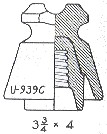
Martin Caverly reported a very crude U-191
unmarked Thomas insulator. The crudeness adds great character but the most
attractive part of the insulator is the glaze color which is a pretty light gray
color. The insulator was made of dry process porcelain. All dry process
porcelain insulators made by Thomas during the 1910' s have a flat-topped
pinhole. This insulator may be one of the earliest Thomas dry process
insulators. The gray glaze indicates that it was made sometime between about
1905 and 1912 at the latest. Two gray U-191' s were reported in the survey for
the Value Guide so Marty's insulator must be pretty hard to find. Marty offers
the following story about how he found the gray U-191:
"I was over on the west side of Michigan on telephone business this past
summer. I had about a five hour drive home so I decided to get out my antique
guide and my climbers and hunt for insulators on the way. I stopped at an
out-of-the-way junk shop and met a neat old guy. I asked him If he knew where
there might be any good insulator hunting spots in the area. He said no, but we
got to talking about all the old neat stuff in his shop. He sent me off to
another antique shop by way of his short cut on the back roads. I went a couple
of miles down the road, turned the corner, and spotted a lone telephone pole
with two colored ponies on it. I got out my binoculars and saw that there were
two old CD 102 Brookies up there. I went up the pole and recovered two mint,
great colored ponies. One was olive and one was emerald green. I was happy as a
pig in mud. I drove on over to the middle of the state and stopped in the city
of Mt. Pleasant at an antique shop listed in the Michigan Antique Guide. I went
in and scanned the place for insulators. That's when I saw a whole table full of
porcelain power pieces. All were very common and very overpriced. I was so
disappointed. Right about then I noticed something white down near the middle of the table. I then looked down in the middle and spied
this little old tramp. It was buried beneath the towering power pieces. It was
so little and so crude looking, I wondered just what it might be. I picked it up
to inspect it and noticed that it was marked $1.00 on the tag. The shop owner
thought it so crude and pitiful that they decided to put a dollar on it in hopes
that it would be sold and out of there. I left the shop and headed home now
happier than two pigs in mud. When I got home I looked it up in the Value
Guide.
It looks like something a 4-year old hand carved but it has no noticeable flaws
or damage. The neatest part is that I didn't find it in a dump, a ditch, or on a
pole but I found it in an antique shop for a buck. So the moral of the story is,
"Never stop hunting down those precious insulators because they're out
there just waiting to be discovered."
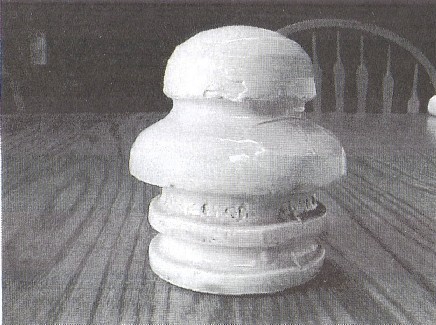
Very crudely made gray, dry process U-191 made by Thomas.
Thanks, Marty, for a great story.
Dave Sztramski (NIA #5666) had a very interesting article in the November 1998
Crown Jewels of the Wire about a white porcelain insulator that he found at the
Brookfield factory site. I assigned it U-106B. That insulator was made from dry
process porcelain and had the embossed marking "AM TEL & TEL CO."
All evidence indicates that Brookfield did indeed try to produce porcelain
insulators. It appears that Brookfield used glass molds to make the U-106B but
were unaware of the shrinkage porcelain experiences during firing. The pinhole
in the U-106B doesn't' look a lot smaller at first glance, but it is much too
small to screw on a standard pin -- apparently due to shrinkage. Dave made
another trip to the Brookfield site with Jeff Katchko (NIA #1668) this past
October. He called me that same evening with the exciting news that they found
another U-106B with the same embossed marking. However, the most interesting
news was the glaze color. The glaze is a very pretty medium blue with much
lighter areas where the glaze thinned around the edges of the wire groove. The
blue glaze is different than any I have seen. About 2/3 of the skirt is missing
which takes out the first part of the marking. The only part of the marking that
is intact is "& TEL CO.". Finding these two specimens of new style
U-106B will easily compete for "find of the decade".
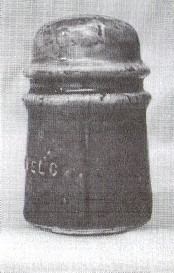
U-106B with
pretty medium to light
blue glaze found at the Brookfield
factory site.
No other pieces of U-106B have been found at the site and access will soon be
covered over due to apartment construction if it hasn't been already. Dave found
several pyrometric cone-plaques during his recent dig. They contained cones 2
thru 8 (2128°F to 2305°F) which is a bit too low a temperature range for
porcelain manufacture. Cone-plaques with cones 9 thru 12 (2336°F to 2419°F)
are typically found at wet process porcelain factory sites. Either dry process
porcelain required lower temperatures (which I doubt) or the cone blocks found
at the Brookfield site were associated with stoneware making, which requires
lower temperatures than porcelain vitrification temperatures. Stoneware is fired
using cones 5 thru 10. I believe bricks are considered earthernware which are
fired at with cones 07 thru 03 (1803°F to 2014°F); therefore too low for the
cone-plaques found at the Brookfield site. Refer to PIN in the May 1998 issue of
Crown Jewels of the Wire for more information on cone-plaques.

Cone-plaque with cones 2 thru 8 found at Brookfield factory site.
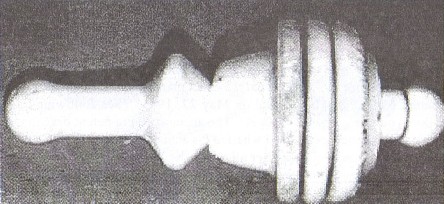
Is this "whatisit" actually an insulator? Care to guess again?
I've received several questions this year about the following
"whatisit". It is made of white-glazed porcelain. Almost everyone
thinks it can be an insulator or some kind even though it does not resemble any
known insulator. We have run a photo of it several times over the years. With so
many new people in the hobby now, it appears time to discuss this interesting
"whatisit" again. It apparently is indestructible as it often can be
found in a box of junk at flea markets.
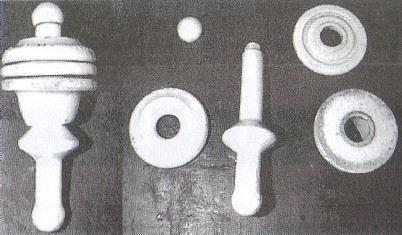
I do not remember who emailed me this nice photograph. I apologize for losing
your name. On the left side of the photo is shown the "whatisit"
complete as assembled. On the right side are the five parts shown separately.
There is a center rod, three disks, and a knob that screws down on the rod to
hold the assembly together. All parts are white-glazed porcelain and one of the
disks has an embossed marking referring to a patent. I do not remember what the
exact marking is. The patent refers to patent No. 2,376,410 granted on May 22,
1945. (See following page.) Have you guessed what it is yet? The accompanying
patent drawing will give you a better idea. The "whatisit" is actually
the internals to a coffee filter! The disks act as a filter allowing the liquid
to pass through while preventing the coffee grinds from falling into the brewed
coffee. Now that you know that it is not an insulator, you might wish you would
have guessed that it looked more like a baby rattle for a baby elephant. Its
sturdy construction and loud rattling noise would make it ideally suited for
that purpose.
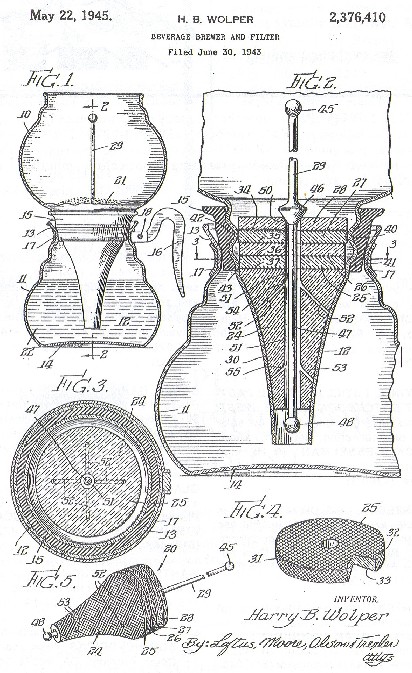
| 